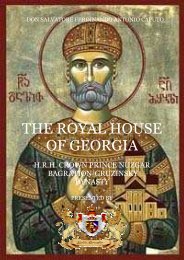here - Nobility Associations
here - Nobility Associations
here - Nobility Associations
Create successful ePaper yourself
Turn your PDF publications into a flip-book with our unique Google optimized e-Paper software.
during his vicariate that he ventured north of the Apennines. At Parma he met his<br />
half-brother Enzo and his father's other loyal supporters—Manfredi Lancia, Oberto<br />
Pelavicino, Ezzelino da Romano, Pietro Ruffo and Taddeo da Sessa. At Parma he<br />
was also formally enfeoffed as count of Albe, his father-in-law's old benefice. He<br />
had to return swiftly to Florence, however, to prevent it from falling under the<br />
control of the Papal legate Ottaviano degli Ubaldini.<br />
After defeated the Florentine uprising in the summer of 1247, the loyalty of even<br />
the Ghibelline centers was pragmatic rather than ideological. A second Florentine<br />
rebellion in the summer of 1250 defeated his troops near the loyal town of Figline.<br />
Frederick's representatives were chased from the city and a new government, called<br />
the Primo Popolo (People First), was instituted in Florence. When Emperor<br />
Frederick II died on 13 December 1250, although Frederick and Galvano Lancia<br />
learned of his death within a week (between 18 and 20 December), most of the<br />
imperial officials in Tuscany abandoned their posts. His administration having<br />
collapsed, Frederick nonetheless remained in Tuscany until the autumn (1251).<br />
Count in the kingdom of Sicily<br />
By February 1252, Frederick had joined his half-brother and father's heir, Conrad<br />
IV, in southern Italy. At a meet of the court in Foggia, Conrad confirmed<br />
Frederick's possession of the county of Alba and conferred on him those of Celano<br />
and Loreto Aprutino. Together Alba and Celano had once formed the county of the<br />
Marsi. Neither of these new acquisitions, however, were in Conrad's hands at the<br />
time. In 1247, Pope Innocent had restored Count Thomas of Celano and his son<br />
Roger to the lands the emperor had confiscated from them, and after the latter's<br />
death in 1250 they re-occupied them. Loreto Aprutino had been bestowed by the<br />
emperor on Count Thomas II of Aquino, but the latter went over to the Guelf side<br />
after Pope Innocent confirmed his possessions in June 1251. At Foggia, Conrad<br />
declared Loreto forfeit and transferred it to Frederick. Beginning in the summer of<br />
1252, Frederick, with the help of Gualtiero di Manoppello, re-conquered the<br />
counties of Loreto and Celano. The castle of Loreto was the last fortress to fall<br />
(1253).<br />
Conrad increasingly distrusted Frederick because of the latter's strong connections<br />
to the Lancia family: his son Corrado Caputo was married to Beatrice, whose father<br />
Galvano was long associated with Frederick in Tuscany. In 1253, perhaps fearing a<br />
Lancia coup to seize the Kingdom of Sicily, Conrad stripped his illegitimate halfbrother<br />
Manfredi Lancia of all his fiefs save the Principality of Taranto. Frederick<br />
and Galvano hired two Genoese ships at Tropea and embarked with their retinues<br />
to leave the kingdom.<br />
In July 1254, Pope Innocent summoned Manfredi, Frederick and the Count of<br />
Hohenberg to a council at Anagni. On 8 September the pope excommunicated<br />
The Hohenstaufen Dynasty - Page 131 of 200



